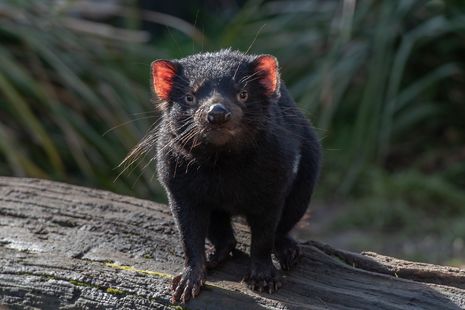Cancer, the ultimate malady across species
Lucie Gourmet gives an overview of cancer biology and explores how cancer incidence varies across species, interviewing Professor Elizabeth Murchinson to understand how other species can teach us about cancer biology

Contrary to our anthropomorphic view, cancer is not a disease specific to humans. In fact, cancer has been suggested to originate from the transition of unicellularity to multicellularity, the latter being viewed as an evolutionary process that is reliant on intercellular cooperation. This atavism hypothesis of cancer suggests that cancer cells lose their multicellular identity by activating the expression of genes belonging to unicellular organisms, becoming more ‘selfish’ in the process and failing to function for the overall wellbeing of the organism. However, there are many limitations regarding this theory. For example, unlike single-cell organisms, a tumour cannot survive without its host and thus behaves rather like a parasite.
Basics of cancer
Cancer is a complex pathology characterised by various levels of heterogeneity: cells within the same tumour can have different mutations, giving rise to different morphology, biochemistry and physiology. Every cancer is unique and is challenging to characterise as multiple factors are involved, such as the type of tissue affected and the species concerned. Cancer affects almost every multicellular organism on the tree of life, manifesting in slightly different ways across these species. Cancer-like phenomena involving abnormal proliferation have even been reported in fungi and bacteria. Furthermore, more complex manifestations of cancer involving invasion or metastasis were seen in plants, red algae and molluscs. It is also important to note that some organisms displaying complex multicellularity such as comb jellies and acorn worms have no cases of cancer.
“Cancer affects almost every multicellular organism on the tree of life”
Even with these varying incidences across a diverse range of species, we can identify common hallmarks of cancer — such as resisting cell death, evading growth suppressors, enabling replicative immortality, inducing angiogenesis, activating metastasis and sustaining proliferative signalling.
The importance of comparative oncology
I interviewed Prof Elizabeth Murchinson, who works on comparative oncology in Cambridge. She explained that cancers, whether in humans or animals, are due to the accumulation of mutations in a cell’s DNA over time. These genetic changes can be the result of exposure to carcinogens or defects in DNA damage repair, and despite the different causes, they are subject to the same evolutionary processes: positive selection (where the mutation acquired provides a cell with a fitness advantage) and genetic drift (where the presence of a mutation in a population of cells increases by chance). Because the processes underlying cancer are the same in animals, working on model organisms is essential for developing cancer treatments. One such animal is a marsupial known as the Tasmanian devil, in which tumours as so similar to human tumours that human anti-cancer drugs could potentially be applied for their treatment. However, there is one major difference: tumours in Tasmanian devils are transmissible!
The curious case of transmissible cancers
There are only three transmissible cancers which simply rely on the direct transfer of cells. These naturally occurring examples affect dogs, soft-shell clams, and Tasmanian devils. In the latter case, devil facial tumour disease (DFTD) can be passed during fights via biting. There are two independently evolved transmissible cancers affecting Tasmanian devils: DFT1 (in 1996 in north-eastern Tasmania) and DFT2 (in 2014 in south-eastern Tasmania). This incredible discovery has many implications. Notably, transmissible cancers occur more frequently than expected, and are thus a great danger for the Tasmanian devil population.
Transmissible cancers can also be seen in dogs, where canine transmissible venereal tumour (CTVT) is the oldest and most prolific cancer lineage known. These tumours are composed of cells from the original dog in which the cancer appeared 6,000 years ago in Asia. CTVT spread quickly around the globe through sexual contact but for a long-time mutations have been accumulating randomly without increasing the aggressiveness of cells.
“This proves that we can learn more about cancer than we may expect by focusing on other models than ourselves”
In a certain sense, it seems like this cancer in dogs was domesticated by adapting to its environment for such a long period. This gave rise to a new strategy for treating cancer called adaptive therapy, which is based on giving drugs intermittently to avoid resistance due to a single treatment. This way, the tumour is kept small and stable instead of causing additional damage. Overall, this proves that we can learn more about cancer than we may expect by focusing on other models than ourselves.
We have much left to learn in the field of cancer biology. As our understanding improves, our capacity to treat and manage patients will cancer will likely improve in tandem. Lessons learnt from other species may well pave the way for new advances in this crucially important field.
 News / Caius mourns its tree-mendous loss23 December 2025
News / Caius mourns its tree-mendous loss23 December 2025 News / Cambridge welcomes UK rejoining the Erasmus scheme20 December 2025
News / Cambridge welcomes UK rejoining the Erasmus scheme20 December 2025 News / CUP announces funding scheme for under-represented academics19 December 2025
News / CUP announces funding scheme for under-represented academics19 December 2025 News / King appoints Peterhouse chaplain to Westminster Abbey22 December 2025
News / King appoints Peterhouse chaplain to Westminster Abbey22 December 2025 Interviews / Politics, your own way: Tilly Middlehurst on speaking out21 December 2025
Interviews / Politics, your own way: Tilly Middlehurst on speaking out21 December 2025








